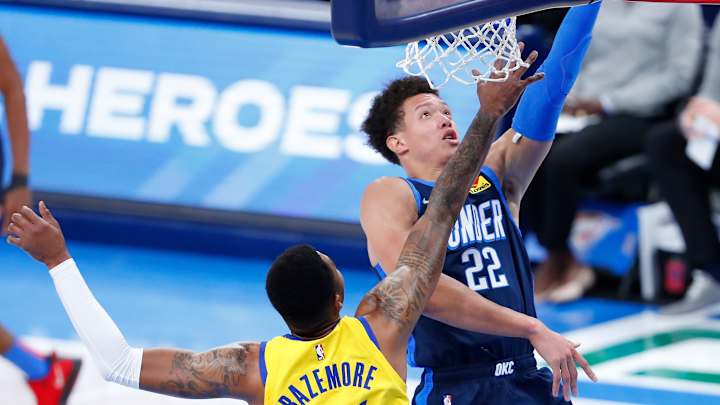OKC Thunder's Isaiah Roby Emerged Quickly During 2020-21 Season

Isaiah Roby isn’t a rookie by NBA rule, but he might as well be. After being selected No. 45 overall in the 2019 NBA Draft by the Dallas Mavericks, he spent the majority of his rookie season in the G League.
It wasn’t until he was traded to the Oklahoma City Thunder mid-season that he actually got his first NBA action. Even then, it wasn’t enough for him really adapt to the speed of the game. Through three games hitting the court for the Thunder, Roby totaled 11 minutes in his true rookie season.
READ MORE:
Thunder Mock Draft: OKC Lands 4th Pick
Thunder Land 4th Best Odds Following Tiebreaker
Coming into year two, Roby would have the opportunity to see an exponentially increased role. However, throughout training camp and the preseason, he had to battle for a roster spot. When it was all said and done, he earned one of the final spots and would be carried into the 2020-21 season with the Thunder.
While Roby didn’t touch the floor through the first two games of the season, he finally got his opportunity in the third. In fact, he’d get the start at center in place of Al Horford and go on to notch over 28 minutes, over doubling the amount of minutes he played his entire rookie season.
This is why many would consider the 2020-21 season essentially Roby’s rookie year.
In this debut game, he would show flashes of what he can do at the NBA level. For the first time, he got enough minutes to put together a full game body of work. Roby would score 19 points on 9-for-12 shooting and pulled down seven rebounds. This was the first NBA contest in which he was playing more than just garbage minutes at the end of a game.
From there, he would continue to earn minutes off the bench in the games following and continued to look more and more comfortable on the floor. Standing at 6-foot-8, Roby is really a guy who should be playing either forward position, but had found a niche at backup center in OKC.
With Thunder Head Coach Mark Daigneault liking to play small and with pace, Roby fit his style perfectly with the ability to rebound and bring the ball up the court when needed. To Roby, playing point-center is what makes him so unique both offensively and defensively.
HELLO 🔨@roby_isaiah | #ThunderUp pic.twitter.com/Ow0eAYUuVt
— OKC THUNDER (@okcthunder) May 17, 2021
“Defensively, I think I’m able to defend any position in the NBA,” said Roby in his exit interview. “I think I started a game guarding every position.”
With this in mind, Roby knows he has plenty of room to improve and wants to come back even better next season. At the end of the season, he mentioned taking care of the ball, building more strength and getting better at blocking out bigger players as the things he wants to continue to improve upon.
These all align with the role he played in small ball lineups for the Thunder last season. These are skills that differentiate him from other young forwards around the league and will only help him better fit in with the modern NBA game.
🧈 & 🍞@roby_isaiah | #ThunderUp pic.twitter.com/uZtUJHRW1d
— OKC THUNDER (@okcthunder) April 30, 2021
During the 2020-21 season, Roby could feel the respect he was starting to gain around the league when opposing players would mention his name throughout the game. In his rookie season, he wasn’t on any scouting reports since he never saw the floor. Just being recognized felt special for Roby.
When it was all said and done, Roby played in 61 games (34 starts) for the Oklahoma City Thunder, averaging 8.7 points, 5.6 rebounds and 1.8 assists in 23.4 minutes per game. While he only shot 29.4 percent from beyond the arc, he has a smooth stroke and should naturally improve as his career goes on.
𝚠𝚘𝚛𝚝𝚑 𝚊𝚗𝚘𝚝𝚑𝚎𝚛 👀 𝚘𝚛 𝚝𝚠𝚘@roby_isaiah pic.twitter.com/bfd2xo5zRp
— OKC THUNDER (@okcthunder) March 5, 2021
At the end of the season, Roby was very thankful for the opportunity he got with the Thunder.
“I was definitely very appreciative of their opportunity this season.”
In his first real season playing significant minutes, Isaiah Roby exceeded expectations in a big way. While he likely isn’t a long-term starter on this Thunder team, he will bring a ton of versatility off the bench going forward with how many positions he can play on both ends of the floor.

Nick has spent the last four seasons covering the Oklahoma City Thunder and has grown quickly in the media since starting. He’s continued to produce Thunder content through writing for Forbes.com and podcasting with The Uncontested Podcast, as well as branching out to cover the NBA as a whole for SLAM Online.
Follow CrainNBA